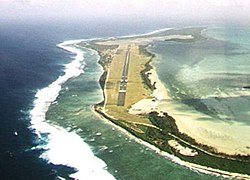Cocos (Keeling) Islands Airport | |||||||||||
|---|---|---|---|---|---|---|---|---|---|---|---|
 Aerial view in the direction of Runway 33 | |||||||||||
| Summary | |||||||||||
| Airport type | Public | ||||||||||
| Operator | Toll Remote Logistics | ||||||||||
| Location | West Island, Cocos (Keeling) Islands | ||||||||||
| Elevation AMSL | 10 ft / 3 m | ||||||||||
| Coordinates | 12°11′19″S096°49′50″E / 12.18861°S 96.83056°E | ||||||||||
| Website | cocosislandairport | ||||||||||
| Map | |||||||||||
| Runways | |||||||||||
| |||||||||||
| Statistics (2010/11 [a 1] ) | |||||||||||
| |||||||||||
| Sources: Australian AIP and aerodrome chart [1] Passenger and aircraft movements from the BITRE [2] | |||||||||||
Cocos (Keeling) Islands Airport (Cocos Islands Malay : Lapangan Terbang Pulu Koko (Keeling)) ( IATA : CCK, ICAO : YPCC) is an airport serving the Cocos (Keeling) Islands, a territory of Australia located in the Indian Ocean. The airport is on West Island, one of the South Keeling Islands and capital of the territory.




